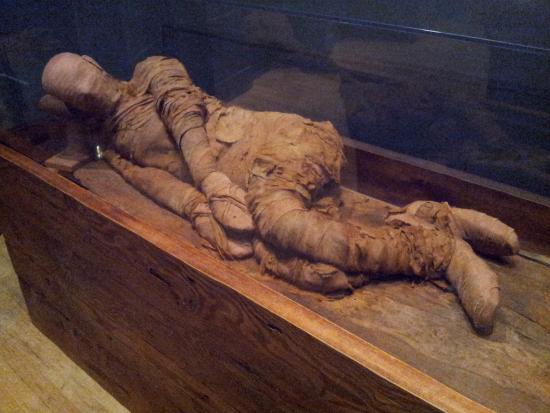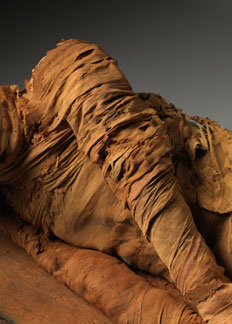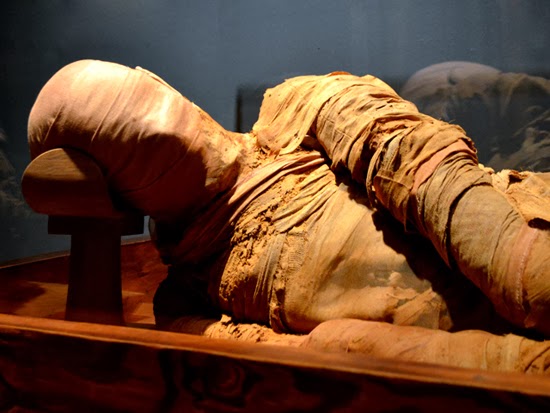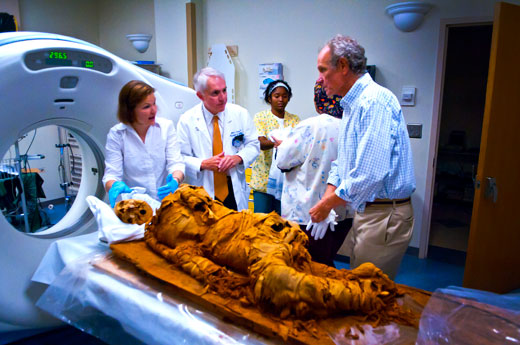Carlos Museum exhibit unveils oldest Egyptian mummy in Western Hemisphere
The conservation team used radiology to assess the mummy.
The mummy from 2300 B.C. was in a sorry state when he arrived at Emory in 1921. Headless, his neck bones had tumbled into his abdominal cavity. Gaping holes and sagging linens marred vague remnants of shoulders, hips and knees. One conservator likened his physique to a crushed bag of potato chips.
Today, the oldest Egyptian mummy in North America has a new lease on the afterlife and will be featured in an upcoming Michael C. Carlos Museum exhibit, thanks to a patient group of Emory conservation experts, anthropologists and doctors.
Opening Sept. 10, “Life and Death in the Pyramid Age: The Emory Old Kingdom Mummy,” places the mummy in the context of ancient Egypt’s burial rites and rituals, along with exploring the social and political changes at the end of the Pyramid Age. Approximately 120 objects from the Carlos Museum’s collection and borrowed from other museums and private collectors will be on display through Dec. 11.

They include a life-size replica of an Old Kingdom tomb, “magic” vessels and wands used to recite spells on the dead, and a rare statue of Pharaoh Pepi, who ruled during the mummy’s lifetime. Visitors will also have an opportunity to watch videos and follow the blogs of archaeologists excavating at the sacred site of Abydos in Middle Egypt, where the mummy was found nearly a century ago. The blogs can be accessed at iabydos.wordpress.com.
“This mummy is a very important piece. We’ve finally been able to conserve it and put it on display,” says Peter Lacovara, the Carlos Museum’s senior curator of ancient Egyptian, Nubian and near Eastern art.
Restoring dignity

“Life and Death in the Pyramid Age: The Emory Old Kingdom Mummy,” opens Sept. 10.
It was a long road to get the mummy ready for prime time.
Acquired by Emory theology professor William A. Shelton in 1920, the mummy was the first inventoried object in what was then the Emory University Museum of Art and Archaeology.
Dismissed as a massive reconstruction effort, the mummy was squirreled away in two crates in storage (one for his body and one for his head, that had fallen off).
At Lacovara’s nudging, the mummy identified as “1921.1” was retrieved about a year ago and carefully transported to Emory University Hospital for X-ray and CT radiographic imaging.

Modern technology revealed much about the early mummification process, which used a combination of salts, oils and resin. It also permitted the conservation team to peer inside the mummy to assess the body’s condition without actually unwrapping him.
Exposing the body would have been disrespectful as well as damaging, notes Carlos conservator Renee Stein.
“The overarching goal of the project was to restore some structural integrity to the body and dignity to human remains,” she says.
With the help of radiology professor William Torres, who has examined several Carlos mummies, the conservation team learned that the mummy’s bones were well-mineralized, it hadn’t suffered any major head trauma and it hadn’t been prone to ear infections. Although his pelvis was obscured, the group determined that the mummy was most likely a male, given the size and shape of his skull.

All in all, “this was a pretty healthy individual,” says Goodrich C. White Professor of Anthropology George Armelagos, who was involved in the examination effort.
In light of the physical evidence and that the mummy had been buried at a holy site, conservators safely assumed that the mummy had access to a good diet and other social advantages. The cause of death, however, remained a mystery.
A team effort
The team quickly mobilized. Given the project scope, the Carlos Museum called on Mimi Leveque, a freelance conservator from Boston. Leveque has lent her expertise to several of the dozen mummies in the Carlos collection, the youngest of which is 2,000 years old.
One of the most glaring issues with the Old Kingdom mummy was his displaced head. The mummy originally was laid on his right side (a common burial position at the time), his head supported by a headrest. Over time, the headrest had been lost, along with the bulk of his coffin, leaving the head unsupported.
As a solution, Leveque relied on low-tech methods, carving out a piece of archival-quality foam and wedging it in the hollow between the mummy’s collar bones and shoulder blades. She then threaded a padded dowel in the foam and through the hole at the base of the skull.
The mummy’s jaw was cast from a mold from a similarly-sized, more modern jaw found in Armelagos’ lab. Two undergraduate interns used an epoxy putty to form missing bones for the hands and feet. They placed the bones inside padded papier mache forms, wrapped in modern linen that was dyed to match the ancient wrappings.
Once intact, the mummy appeared lifelike, as if he had just lain down to sleep.
Eventually the mummy, one of only a half-dozen from that period who have survived, will be a permanent fixture at the Carlos. Due to his fragility, he will not tour.
Ancient Egyptians believed that by visiting tombs and actively remembering the dead through images, mummies were kept alive in the afterlife, explains Lacovara.
“In recreating the tomb and restoring the Old Kingdom mummy, we are fulfilling his wish,” he says.
Related Post
A shocking documentary proves that mermaids do exist
SHOCKING Revelation: Thuya, Mother of Queen Tiye, Was the Grandmother of Akhenaten and Tutankhamun—What Ancient Egyptian Secrets Did She Leave Behind?
Breaking News: Astonishing Discoveries at Karahan Tepe Confirm an Extraterrestrial Civilization is Hiding on Earth, and NO ONE Knows!
Breaking News: Researchers FINALLY Discover U.S. Navy Flight 19 After 75 Years Lost in the Bermuda Triangle!
NASA’s Secret Investigation: Uncovering the Astonishing Mystery of the UFO Crash on the Mountain!
Explosive UFO Docs LEAKED: Startling Proof That Aliens Ruled Ancient Egypt!
